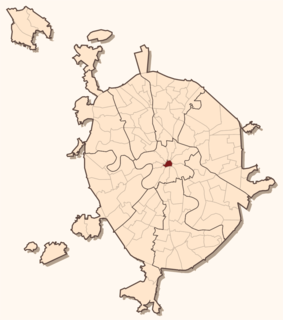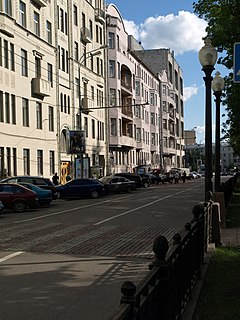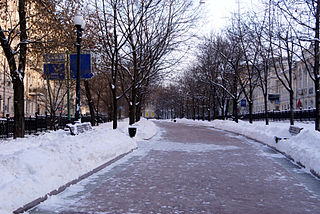This article does not cite any sources .(December 2009) (Learn how and when to remove this template message) |

Arbatskaya Square or Arbat Square (Russian : Арба́тская пло́щадь) is one of the oldest squares of Moscow, located on the junction of Gogolevsky Boulevard, Znamenka Street and Arbat Gates Square (in 1925–1993 – part of Arbatskaya Square).

Russian is an East Slavic language, which is official in the Russian Federation, Belarus, Kazakhstan and Kyrgyzstan, as well as being widely used throughout Eastern Europe, the Baltic states, the Caucasus and Central Asia. It was the de facto language of the Soviet Union until its dissolution on 25 December 1991. Although, nowadays, nearly three decades after the breakup of the Soviet Union, Russian is used in official capacity or in public life in all the post-Soviet nation-states, as well as in Israel and Mongolia, the rise of state-specific varieties of this language tends to be strongly denied in Russia, in line with the Russian World ideology.

Moscow is the capital and most populous city of Russia, with 13.2 million residents within the city limits, 17 million within the urban area and 20 million within the metropolitan area. Moscow is one of Russia's federal cities.

Gogolevsky Boulevard is a boulevard near the Arbat District, Moscow, Russia, named after the writer Nikolai Gogol. It was named Prechistensky Boulevard until 1924, after the nearby street Prechistenka.
The square is home to the Arbatskaya metro station, on Filyovskaya Line.

The Moscow Metro is a rapid transit system serving Moscow, Russia and the neighbouring Moscow Oblast cities of Krasnogorsk, Reutov, Lyubertsy and Kotelniki. Opened in 1935 with one 11-kilometre (6.8 mi) line and 13 stations, it was the first underground railway system in the Soviet Union. As of 2018, the Moscow Metro excluding the Moscow Central Circle and Moscow Monorail has 224 stations and its route length is 381 km (237 mi), making it the fifth longest in the world. The system is mostly underground, with the deepest section 84 metres (276 ft) underground at the Park Pobedy station, one of the world's deepest.
Present-day square is dominated by the wide avenue of New Arbat, however, prior to redevelopment of the 1960s, the square was located south from this avenue, on the line of Arbat Street and the vestibule of Arbatskaya subway station. Arbat Gates of Bely Gorod were located here; the wall of Bely Gorod was demolished in the 1750s-1770s, the tower in 1792, creating the original Arbat Gates Square.

Bely Gorod is the central core area of Moscow, Russia beyond the Kremlin and Kitay-gorod.
There was no straight connection between Vozdvizhenka and Arbat: westbound coaches had to make a sharp turn south into Nikitsky Boulevard, past a corner block on this boulevard, then make a turn west into either Arbat, Povarskaya Street, Bolshaya Molchanovka, Malaya Molchanovka or Merzlyakovsky Lane. All these four streets fanned out west from the square. In 1807–1812, it hosted Arbatsky Theater [ ru ], which perished in the Fire of Moscow (1812), as well as most of the neighborhoods around it.

Povarskaya Street, known from 1924–1991 as Vorovsky Street, is a radial street in the center of Moscow, Russia, connecting Arbat Square on Boulevard Ring with Kudrinskaya Square on the Garden Ring. It is known informally as Moscow's Embassy Row, and is home to the finest mansions built in the 1890s and 1900s. Povarskaya Street also houses the Supreme Court of Russia and the Gnessin State Musical College.

The 1812 Fire of Moscow broke out on 14 September 1812, when Russian troops and most of the remaining residents abandoned the city of Moscow just ahead of Napoleon's vanguard troops entering the city after the Battle of Borodino. The fire all but destroyed the city, which had been mostly abandoned by its residents the previous month.
The Arbat Fountain, originally a fire reservoir (1840s), later a decorative fountain, was located in the south of the square, on the line of Maly Afanasyevsky Lane. In 1945, it was refitted with sculptures and granite slabs in stalinist style, only to be destroyed in the 1960s.

Stalinist architecture, mostly known in the former Eastern Bloc as Stalinist Empire style or Socialist Classicism, is a term given to architecture of the Soviet Union under the leadership of Joseph Stalin, between 1933, when Boris Iofan's draft for Palace of the Soviets was officially approved, and 1955, when Nikita Khrushchev condemned "excesses" of the past decades and disbanded the Soviet Academy of Architecture. Stalinist architecture is associated with the socialist realism school of art and architecture.
Coordinates: 55°45′07″N37°36′04″E / 55.7519°N 37.6011°E

A geographic coordinate system is a coordinate system that enables every location on Earth to be specified by a set of numbers, letters or symbols. The coordinates are often chosen such that one of the numbers represents a vertical position and two or three of the numbers represent a horizontal position; alternatively, a geographic position may be expressed in a combined three-dimensional Cartesian vector. A common choice of coordinates is latitude, longitude and elevation. To specify a location on a plane requires a map projection.
| Wikimedia Commons has media related to Arbatskaya Square . |













